Everyone wants to live in comfort and warmth. For residents apartment buildings that are connected to centralized system heating is not a problem. But what about those whose homes are not connected to heating mains? There can be many solutions to a problem. One of them is to install electric boilers for heating the house. The devices are designed to convert electrical energy into thermal energy. How practical is such equipment? Let's figure it out.
Advantages of heating a house with an electric boiler
Electric boilers are simple and quite effective devices. By converting electricity into heat, they heat up the coolant, which is sent to the radiators and heats the room. The advantages of such systems are:
- Simplicity of design, which greatly facilitates maintenance.
- No need to stockpile fuel.
- There is no need to allocate a special place to install the device.
- The device does not require a chimney to operate.
- Environmental safety. Toxic substances are not emitted during boiler operation.
- There is no threat to the safety of people living in the house. There is no possibility of gas leakage or explosion.
- Dual-circuit units are produced that provide housing with both heat and hot water.
Electric boilers transform electrical energy into the heating room and heat the coolant to the desired temperature
However, heating a private house with an electric boiler also has disadvantages. The biggest of them is the insufficient efficiency of the system. You need to understand that the device does not heat the room “directly”, as, for example, convectors do, but indirectly. The presence of an intermediate link, a coolant, implies additional energy losses and, accordingly, costs. In addition, the device consumes large number electricity, the cost of which is constantly rising.
Another drawback electrical appliances– insufficient resistance to power surges, which very quickly damage the automation. For high-power boilers, a three-phase 380 V network will be required.
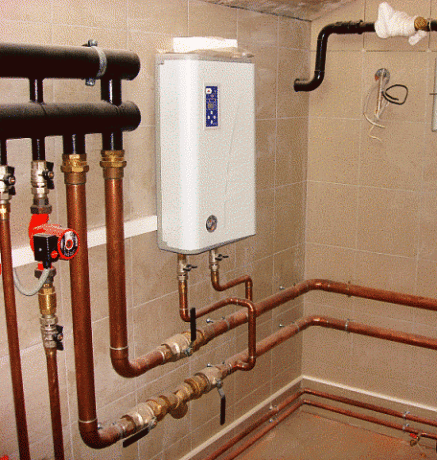
The electric boiler does not require a chimney to operate, and there is no need to allocate a special room for installation of the device.
Types of electric heating boilers
All electric boilers for heating a house can be divided into three groups. Let's take a closer look at each of them.
Devices with heating elements
From the name it becomes clear that plate or tubular heaters, so-called heating elements, are used to heat the coolant. They are located directly in the water tank. The power of the device is regulated by stepwise connection of heating elements. For example, a 16-kilowatt device houses eight 2-kW electric heaters. Automation gradually connects as the liquid cools required quantity heating elements. The maximum boiler power can be limited via the control panel. In this case, dual-circuit devices can use a container with heating elements to heat water. The advantages of devices of this type are:
- Possibility of using any coolant. This could be antifreeze, water or oil.
- Simplicity of devices. They do not use complex structural elements.
- Low cost of devices.
The disadvantages of heating electric boilers for heating a home include their large volume, which is due to the size and number of heating elements. In addition, during operation, scale inevitably forms on heating elements, which impairs the performance characteristics of the device and destroys parts over time.
Electrode heating devices
These devices use a different principle of heating water. Electrodes are placed inside the equipment. A potential difference is created across them. Considering that salts dissolved in water make it an electrolyte, you can understand why a current occurs in the liquid. Moreover, the current is alternating, since the polarity of the electrodes changes with a frequency of 50 Hz. Resistance of the medium when passing through an alternating electric current heats the water. Advantages of the devices:
- Small in size, since devices of this type do not require a large tank.
- Simple design, which greatly facilitates maintenance.
- Low cost.
- Absolute safety of the device. If there is a fluid leak, it simply stops working.
A significant drawback can be considered the system’s demands on the quality of the coolant. This can only be water with a certain resistivity, otherwise the boiler simply will not be able to operate. Another “minus” is the gradual dissolution of the electrodes in water. They require regular replacement.
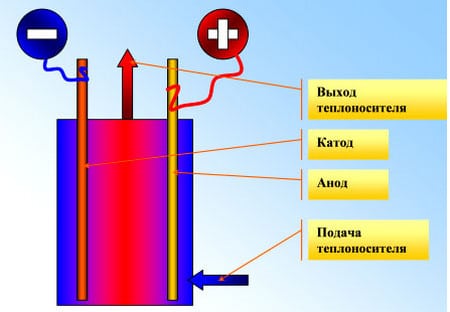
The figure schematically shows the structure of an electrode boiler
Induction electric boilers
Induction devices have a more complex structure. Their design necessarily includes a coil wound around a pipe made of dielectric. A core is placed inside the part. When the device is turned on, an electric current passes through the coil. Due to the phenomenon of electromagnetic induction, current also appears in the core. The induced potential difference provokes strong heating of the core.
The complexity of the design does not cause a drop in efficiency. Induction currents arise exclusively inside the coil; the core absorbs all the energy consumed by the winding. In addition, proper insulation allows you to direct the heat generated by the winding to heat the coolant. Advantages of the device:
- Ability to use almost any coolant.
- Absolute fault tolerance and almost unlimited resource, which is explained by the design features. The winding can serve for a very long time, and the core is not afraid of overheating or scale.
- No detachable connections that are potential leak points.
The only significant drawback of the system is its higher cost compared to other types of boilers.

Diagram of an induction electric boiler
How to choose an electric boiler for heating a private house
When choosing a device, you need to pay attention special attention per row important characteristics.
Features of connecting the device
Electric boilers can have three-phase or single-phase power. In the first case, they must be connected through a special circuit breaker that protects the electrical network. Thus, when choosing a device, you will have to take into account the specifics of the local electrical network, which may simply not withstand the expected loads. Most often, the most powerful models have three-phase power.
Device power calculation
The power of an electric boiler for heating a house is quite simple to calculate. To do this, it is necessary to determine the area of the heated room. Experts say that for a building with an area of 10 sq.m., the ceiling height of which does not exceed 3 m, 1 kW of electricity will be needed. Thus, one can easily determine required power electrical equipment. To those who live in middle lane, and even more so in the north of Russia, it is recommended to add another 10% to the obtained value. Winters in these areas can be very harsh and a small reserve of power will not be superfluous.
Equipment configuration
The configuration of the devices may vary. It is optimal to purchase the device complete with auxiliary equipment. This will cost a little more, but it will be much easier to use the boiler. You can, of course, buy what is missing. But this is quite troublesome, and the material benefits are very doubtful. The required equipment package includes a programmer, expansion tank and circulation pump.
As a useful addition, there may be a variety of devices designed to prevent water from freezing in the boiler or to protect against low pressure coolant. On sale you can find models with summer and winter operating modes, as well as with special filters. Such equipment belongs to the category of mini-boiler houses and is used mainly in permanent residences.
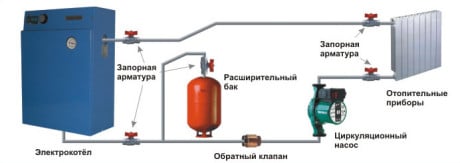
The device must include an expansion tank, a programmer and a circulation pump
Boiler efficiency
As practice shows, the most economical electric boilers for heating a home are devices with adjustable power. If necessary, the power of the devices is increased or decreased, resulting in significant resource savings. Optimal choice– equipment with a built-in thermostat or models to which it can be additionally connected. The thermostat will automatically regulate the operation of the boiler, automatically setting the most economical mode.
Despite the widespread belief that heating country house An electric boiler is a very expensive pleasure; such equipment is popular among developers. This is easily explained by the advantages of heating systems of this type: absolute safety, cleanliness, no worries about creating fuel reserves and the ability to connect anywhere there are power lines. To make the operation of the boiler extremely economical, it is enough to choose the right model, correctly install and adjust it, and also carry out work to maximize the insulation of the building.
Video: review of electric boilers
Few suburban or private house boasts a connection to the main heating system. In the vast majority of cases, concerns about choosing and designing heating systems in such dwellings fall on the shoulders of their owners. There are a lot of options to choose from, but many of them also depend on external conditions. Thus, the lack of gas supply does not allow some to build a heating system based on gas boilers. Systems based on liquid fuel requires compliance with strict safety standards and special qualifications during installation and operation. In this case, a reasonable choice would be to purchase electric boilers for heating a private home. Modern industry produces a lot of modifications of such devices for any operating conditions.
Types of electric heaters for heating private houses
In order to understand which electrically heated boiler can become the basis for building a heating and hot water supply system in your home, you need to understand their basic structure.
Basic elements of electric boilers
Regardless of the power of the electric boiler and its main purpose, it consists of the following main elements:
- The housing, which serves as a container for all components.
- A heat exchanger, which serves to transfer heat from the heating element to the coolant tank,
- Control, control and adjustment units.
A number of models of electric boilers may also have built-in circulation pumps to ensure the movement of coolant, and valves that redirect its flow.
A modern electric boiler is a high-tech device that heats flowing water with maximum efficiency, while operating in a completely autonomous mode. Even a child can operate such equipment - it is so safe and simple. Also, modern electric boilers have a fairly high efficiency, which will allow you to avoid unnecessary bills for wasted electricity.
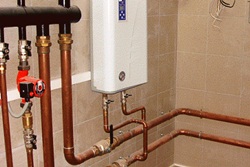
There is a great variety in the design of such electric heating devices. They happen the most various shapes, with wall or floor placement.
Operating principle of electric boilers
Almost all electric boilers operate on the same principle: a heating element is placed in the heat exchanger, which, after applying electric current to it, begins to generate heat. The coolant entering the heat exchanger (usually simple tap water, and in closed heating circuits, water with special additives or antifreeze) is heated after contact with the heating element.
By the way, water can be heated not only by a traditional heating element (that is, a heating coil enclosed in a protective casing), but also by induction or electrode methods. However, it is electric boilers with heating elements that are most widespread, both among imported and domestic models.

The power supply for heating boilers is also very diverse. They can be powered from standard household 220 volts, or they can have industrial food three phases at 380 volts. There are even modifications that are powered by batteries.
What's bad and what's good about electric boilers?
The undoubted advantages of electric boilers designed for heating private houses include:
- Very easy installation, which is accessible even to untrained users.
- If there is good electrical wiring in the house that can withstand the required current, such a boiler does not require additional electrical work. The water distribution when installing an electric boiler is also extremely simple.
- There is no need to install such a boiler in a separate room. The safety measures during its installation are quite gentle and it can be located in any utility room.
- Heating boilers operating on electricity differ in better side from their gas and solid fuel counterparts in weight and size.
- Such boilers are very easy to maintain and do not require constant cleaning and routine maintenance.
- The electric boiler does not emit combustion products and is an absolutely environmentally friendly device.
- The efficiency of modern electric boilers reaches 98 percent, which allows you to save on heating.
But the operation of electric heating boilers also has some disadvantages:
First of all, a boiler that runs on electricity is very critical to the quality of the electrical wiring in the house. Installing such systems in old buildings may require additional costs for installing electrical wiring of the required cross-section.
![]()
In some cases, the energy consumption of a heating boiler can lead to additional costs, especially in areas with high electricity rates.
What to consider when choosing an electric boiler
In order to correctly choose an electric boiler model for heating and hot water supply to your home, you first need to determine the required power of the electric boiler. There are both modest wall-mounted electric boilers with a capacity of 2.5 kilowatts and stationary installations, the effective power of which is measured in tens of kilowatts.
To calculate the required power of an electric boiler, you can use a fairly simple formula - divide the area of the heated premises by 10. The resulting figure will show the required power of the electric boiler in kilowatts. So, if you plan to heat a house with an area of 90 square meters, then the minimum required power of the electric boiler will be 9 kilowatts.
Factors such as the material from which it is built, the degree of insulation and external climatic conditions. All this can make significant adjustments to the required power. Automating the heating process can significantly reduce energy consumption - maintaining several temperature conditions, automatically switched by timer. In this case, the heating will not provide maximum heating during your absence, but will only maintain a minimum required level temperature.
Cost of electric boilers
The price range for electric heating boilers is as wide as their model range. The price of such devices depends on both the power and the functions implemented. In addition, the final cost of installing an electric heating system is significantly influenced by the purchase of additional equipment.
A small wall-mounted device costs several thousand rubles, which can provide an acceptable temperature in a small room. country house, but for an apartment building the price of such equipment will already be several tens of thousands of rubles.
How to install an electric boiler in a private house yourself?
Modern electric boilers, despite all their high-tech, are quite simple devices to install. Schematic diagram The installation of a typical electric heating boiler is shown in the figure.

However, as the design of the boiler becomes more complex and additional circuits are included in the heating system, the installation of such devices also becomes more complicated. Developed systems include not only heating circuits (of which there may be several according to the number of rooms in the house), but also a hot water supply circuit. Each circuit can be equipped with individual temperature sensors, drain and shut-off valves, an inlet filter for coolant water, and circulation pumps.
Therefore, the installation of a heating system based on an electric boiler in a private house must begin with drawing up a detailed project. The project must reflect the required power of heating electrical equipment, calculate the required number and length of pipelines for organizing the circuits of heating and hot water supply systems, as well as all peripheral equipment.
After drawing up the project and calculating the power, the power supply system is reviewed - if necessary, new wires are laid, and a separate emergency switch is installed in the distribution panel.
In the future, installation of the heating and water supply system is carried out according to general rules construction of such systems. When installing yourself, at least at the stage of calculation and drawing up the project, we recommend that you take advantage of specialist consultations.
Electric boilers for heating a private house: video
Owners of private houses and country cottages have to closely design the heating system of their own home, while the choice of a decent option directly depends on external factors. Lack of main gas supply excludes the possibility of connection gas equipment. Installation of heat generators operating on liquid or solid fuel requires special conditions and a specific place for storing flammable raw materials and constant monitoring.
The use of electricity as an energy source for heating a private house or cottage is considered the most expensive option. A review of electric heating boilers, reviews from owners and other aspects that should be taken into account when choosing electrical equipment will help you understand the rationality of using this type of heat supply.
- high efficiency – reaches 99.5%.
- safe and silent operation;
- environmental friendliness;
- ease of installation and operation - do-it-yourself heating installation from an electric boiler in country house will not be difficult, you just need to provide the power supply and the appropriate wire cross-section;
- compact size and light weight;
- affordable price.
Types of electric boilers for cottages
Electrical devices can be direct ( electrode boilers) or indirect action (heating elements and induction).
1. In electrode ones there is no heating element as such; the temperature of the coolant is increased by direct heating due to the flow of current in the coolant between two electrodes. The efficiency of the boiler depends on the electrical conductivity of the water - the higher the degree of mineralization, the better it conducts current.

The cost of a direct heating generator is low; for example, you can buy Galan Geyser-9 electric boilers for an area of up to 120 m2 for 13,800 rubles. At the same time, it is called the most effective and in an economical way heating among all electric heating options, the only drawback of which is the periodic replacement of electrodes and the presence of a mandatory water treatment system.
2. Heating element units are common due to their simplicity of design, affordable cost and ability to work with various types coolants. Main disadvantage– scale formation on tubular heaters.
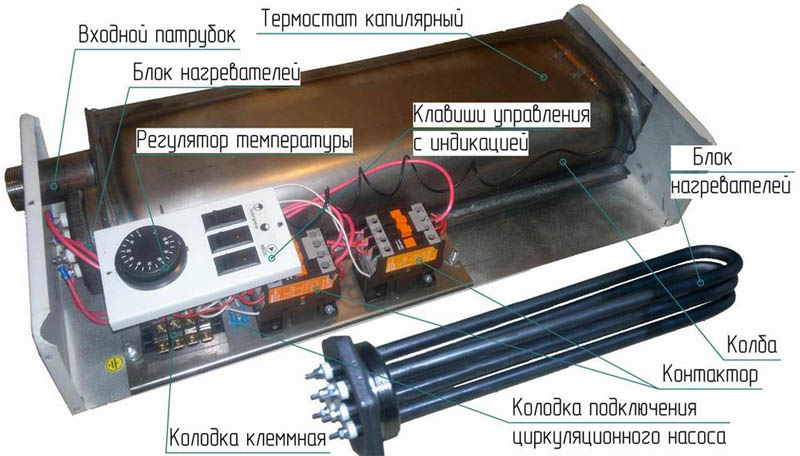
The operating principle of an induction electric boiler is based on the phenomenon of electromagnetic induction. The role of the heating element is performed by the design of the heat generator itself, which is a transformer with a primary and secondary winding. Applying voltage to the coil creates a magnetic field, as a result of which the metal is heated and transfers heat to the liquid moving through the heat exchanger.
You should pay attention to the main characteristics:
- Power. Calculation of the required performance of an electric heating boiler is carried out taking into account the area and insulation of the building. When selecting double-circuit units, additional costs of thermal power for domestic hot water are taken into account.
- Voltage. The rated network voltage for its operation – 220 or 380 V – also depends on the power consumption of the electric boiler. The “correct” cross-section of the cable for connecting electrical equipment must be ensured.
- Type of heating - using a heating element, electrode or induction.
- Number of circuits.
- Comfort of control - automated operation not only simplifies the control of temperature conditions, but also ensures the efficiency of the device.
Choosing electrical systems heating, you need to consider that:
- microprocessor-controlled equipment will relieve others from the constant clicks emitted by the relay when turned on and off;
- electric boilers with a thermostat and programmer, as well as the additional installation of a storage tank and a multi-tariff meter help reduce energy consumption and lower heating costs;
- multi-stage adjustment of the heat generator power allows rational use of electricity and extends the service life of the heaters;
- To protect against low-quality current, it is necessary to use a voltage stabilizer.
Review of manufacturers
Many companies offer a wide range of models and price ranges on the electrical heating equipment market.
1. Vaillant produces wall-mounted single-circuit electric boilers of the eloBLOCK series. All representatives of this line have microprocessor control, smooth multi-stage power changes and a built-in safety group.

The device with the minimum power eloBLOCK VE6 R13 is equipped with two heating elements of 3 kW each, and the highest-performance electric boiler Vaillant VE28 R13 has 4 built-in heating elements with a total capacity of 28 kW. The cost of the first option is 28,400 rubles, and the second can be purchased for 34,400.
2. Single-circuit Czech electric boilers from Dakon in the range from 4 to 60 kW can be included in any heating system. The number of heating elements depends on the power of the heat generator: for example, Daline PTE 6 is equipped with two copper heating elements of 2 and 4 kW, and Daline PTE 30 has four heaters of 7.5 kW each. The price of an electric boiler from Dakon Daline PTE 6 is 54,500 rubles, and PTE 30 is 64,240.
![]()
3. Heat generators from Protherm are considered the most reliable not only in Russia, but also in Europe; they are designed to be powered from a three-phase current network. The SKAT series presented on the market is equipped with a circulation pump and a 10-liter expansion tank, a safety valve and an electronic control unit are provided. Thermal generators from 6 to 28 kW allow operation with antifreeze liquids in the heating circuit. The cost of SKAT 6KR 13 is almost two times lower than its analogue from Dakon and amounts to 24 thousand rubles, and the more powerful SKAT 28 KR 13 is 29,700. A video review of Protherm heating system models will allow you to become better acquainted with the line of electric boilers from the Slovak manufacturer.

4. EVAN offers a wide range of electric boilers with a choice of required option both in terms of power and price. The most budget devices are represented by the Standard-Economy EPO class: the simplicity of the design, the absence of a housing and relay control made it possible to offer the buyer an acceptable price: the price of EPO 6 is only 9,700 rubles.

The improved characteristics of WARMOS (Comfort) thermogenerators take into account the peculiarities of heating a private house with an electric boiler and allow optimizing operation and reducing energy consumption. The possibility of rotating stainless heating elements significantly increases their service life. Buying an EVAN Warmos 30 kW boiler will cost 27,180 rubles.
Luxury heat generators of the Warmos QX series have a set of functional qualities of a mini-boiler room due to built-in equipment: a circulation pump, a 12-liter expansion tank and full group security. The price of such a unit for 27 kW is 41,500 rubles.
5. Russian company RusNIT, unlike previous manufacturers, specialize in producing only electrical devices for heating. The RusNIT M electric boiler is automated: the temperature sensor allows you to maintain the set mode in the room within the range from 5 to 30°C, and the power of the stainless heating elements is adjusted in three stages. The cost of a 220 V electric type 206 M boiler is 15.6 thousand rubles.
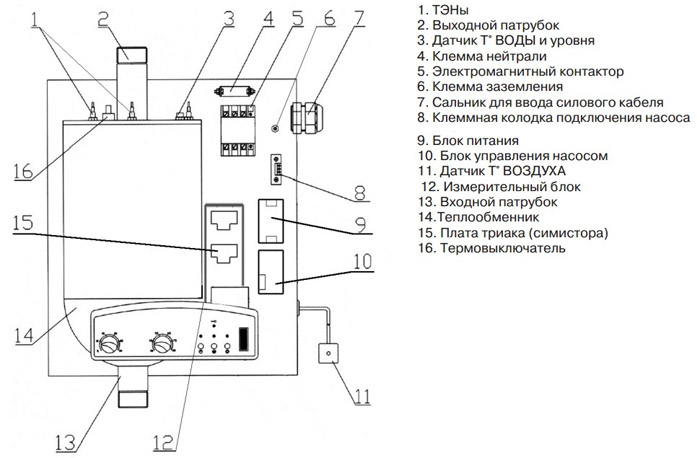
The Country series of heat generators is complemented by a 7-liter expansion tank. Buying the 206 K model will cost 12.9 thousand rubles. The RusNIT N category of electric boilers is a monoblock with built-in basic elements: a stainless heat exchanger, a circulation pump and a control unit. Price 224 NM - 27.8 thousand.
Comparison of electric boilers for a country house or cottage:
| Manufacturer | Series | Model | Power, kW | Voltage, V | Efficiency, % | Dimensions (HxWxD), mm |
| Dakon | Daline | PTE 6 | 6,0 | 220/380 | 99,0 | 695x550x270 |
| PTE 30 | 30,0 | 870x615x335 | ||||
| Protherm | SKAT | 6KR 13 | 6,0 | 220/380 | 99,5 | 745x410x240 |
| 28KR 13 | 28,0 | 380 | ||||
| Vaillant | eloBLOCK | VE6 R13 | 6,0 | 220 | 99,0 | 740x410x310 |
| VE28 R13 | 28,0 | 380 | ||||
| RusNIT | M | 206 M | 6,0 | 220/380 | 93,0 | 505x305x205 |
| Country | 206 K | 6,0 | 220/380 | |||
| NM | 224 NM | 24,0 | 380 | 92,0 | 660x410x260 | |
| EVAN | Standard-Economy | EPO 6 | 6,0 | 220 | 93,0 | 565x270x220 |
| Comfort | Warmos | 30,0 | 380 | 635x380x245 | ||
| Lux | Warmos QX-27 | 27,0 | 380 | 96,0 | 420x775x300 |
Owners' opinions
“In the house, I connected a 14 kW Protherm SKAT electric boiler to a warm water floor collector - the pump’s performance is enough to pump the entire system. Made with high quality, the internal design is thought out - the components are mounted compactly, while being accessible for maintenance.”
Anatoly Lyubashenko, Khimki.
“I installed heating in a private house using an electric boiler RusNIT 207 NM - with a rated power of 7 kW it copes well with heating at 4 kW. I installed it about 5 years ago - nothing broke, the spare parts were original, the heating elements were scale-free - almost mirror-like. At first the coolant did not heat up due to incorrect phasing - I reconnected it and everything worked.”
Sergey Nikolaev, Moscow.
“EVAN EPO Standard-Economy worked as the main electric boiler for three winters - the heating element burned out, replacement was inexpensive - 1,500 rubles. There are no complaints about the operation, but at low voltage 140-150 V it does not produce full power and at the same time the contactor in the control panel begins to burn. I connected the stabilizer and the problem was solved.”
Victor Deryabin, Perm.
According to reviews, the energy consumption of electric boilers in a house with an area of 60 m2 can be about 500-700 kW per month. You can reduce heating costs by insulating all the main structures of the house (walls, foundation, ceiling), installing a multi-tariff meter, connecting a heat storage tank and a set of temperature control automation. Is it worth saving money when buying an electric boiler, but increasing the costs of its operation, or investing once in an efficient unit and reducing additional costs - the choice is up to the consumer.
The climate control company Termomir offers a wide range of electric boilers of various capacities. Read the information or call our consultants to choose the right boiler model.
Electric boilers are designed for heating private house, dacha, apartment (including for apartment heating), various administrative, commercial and industrial facilities ranging from 30 to several thousand square meters. m. Electric heating optimally where there is no main gas or where there are strict requirements for the environmental friendliness of heating devices. Also, an electric boiler is often used as a backup heating option in case problems arise with the main boiler, for example, a gas one.
An electric heating boiler consists of a heat exchanger, a block of heating elements, a control unit and control and safety devices. Some electric boilers are equipped with a circulation pump, expansion tank, safety valve and filter. The coolant heated by electricity circulates through a system of pipes and radiators, providing space heating, as well as heating water in the boiler. An electric double-circuit boiler is used for heating and hot water supply, a single-circuit boiler is used only for heating a house, as well as for heated floors.
Pros:
Compared to boilers using other types of fuel, electric boilers are cheaper, more compact, safe and silent. Connecting electric boilers is much simpler and less expensive than other types of boilers. Due to their compact size and light weight, electric boilers are wall-mounted, do not require a separate boiler room, and installation is allowed in utility or utility rooms, storerooms, kitchens, basements, and even in living rooms.
Electric boilers are easy to use and do not create harmful emissions And foreign odors, do not require constant maintenance, expensive cleaning and regular fuel purchases.
Cons:
Dependence on stable availability of electricity and high demands to the quality and reliability of electrical wiring. It should also be taken into account that high cost electricity. To make an informed decision about purchasing an electric boiler, it is recommended to make a preliminary calculation of electricity costs.
The boiler will be used in the Russian climate on average from September to April inclusive, i.e. only 8, not 12 months a year. In autumn and spring, the boiler will be used at a minimum, in winter - at full capacity. Thanks to the built-in automation, the boiler will not operate continuously, on average about 8 hours a day, so the approximate energy costs for the year can be calculated using the following formula:
240 days X 8 hours a day X boiler power X cost of 1 kW of electricity
Electric boilers with a power of up to 12 kW are available in single-phase (220 V power) and three-phase (380 V power), and boilers with a power of more than 12 kW are only three-phase. Most electric boilers with a power of more than 6 kW allow multi-stage power adjustment.
Various remote programmers that can maintain the room temperature according to a user-specified schedule help save energy without sacrificing comfort.
To select an electric boiler, you need to find out the power of the device. Basic calculation – 1 kW of boiler power is enough to heat 10 m2 of a well-insulated room with a ceiling height of up to 3 m.
To select a specific electric boiler model, you can contact the consultants of the Termomir company. Remember that in addition to the boiler itself, it is necessary to purchase other elements of a complete heating and water supply system (radiators, pipes, pumps, thermostats, boiler and much more), so it is better to entrust the selection of equipment and its complete set to professionals.
Currently, our company’s product range includes both the best electric boilers from European manufacturers and good inexpensive Russian electric boilers.
See also:
The stove as an obligatory attribute of a private home is practically no longer used - the central element is a boiler running on solid, liquid or gaseous fuel.
At the same time, systems that convert electrical energy into heat are becoming increasingly popular, since the availability of electricity is almost universal and only its cost can have a significant impact on the feasibility of using electric heating.
Heat generating electrical installations
The operating principle and design of electric boilers determines power consumption, installation features and economic feasibility. There are three types of installations:
- heating elements;
- electrode (ionic);
- induction
This device is a classic for heat-generating devices based on electricity. The only serious drawback of such boilers is their sensitivity to water hardness: great content salts leads to the formation of scale on the heating element, which greatly reduces the efficiency (up to complete burnout of the element) and leads to increased costs.
If such an electric boiler is used in the heating system, then special attention must be paid to the condition of the water in the circuit. Most often, a special filter is installed at the make-up water inlet to reduce its hardness - this important point for normal and long-term operation.

Boilers with a bottom outlet are more often used for heating systems in one-story houses with a bottom wiring diagram. The upper outlet in the boiler is convenient to use for heating a two-story house or when placing an electric boiler in the basement of the building.
A heat-generating installation of this type is characterized by high efficiency (98 - 99%) compared to a heating element, as well as simplicity of technical design. It does not require changing the design of the existing heating system of the house during installation.
Due to the large temperature difference of the coolant throughout the electrical installation, the boiler without forced circulation is capable of raising the heated liquid to a height of 3 to 24 m, which allows it to be used for heating both a garage and a cottage.
However, for its operation, a coolant with a good thermal conductivity coefficient is required. It must retain its properties for a long time, acting as a source of ions for the system.
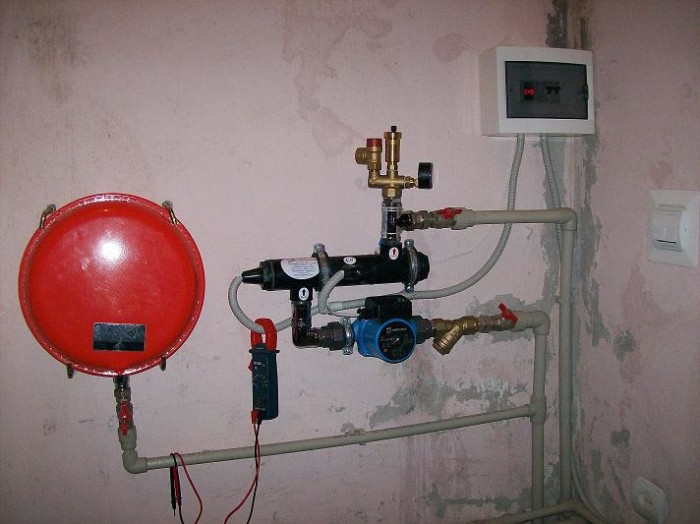
Water, being also an electrolyte, is not always suitable, and therefore the system is filled with special media. It is worth noting that even when using water, the resulting salt deposits do not worsen technical specifications unit.
The latest technology is the use of induction boilers. A feature of energy-saving technology is 99% efficiency, when the coolant heats up in 5–7 minutes.
It does not matter what substance is “poured” into the heating system: the possibility of using oil or antifreeze expands the geography of use of boilers to areas with a harsh climate, when there is a danger of “defrosting” water systems.
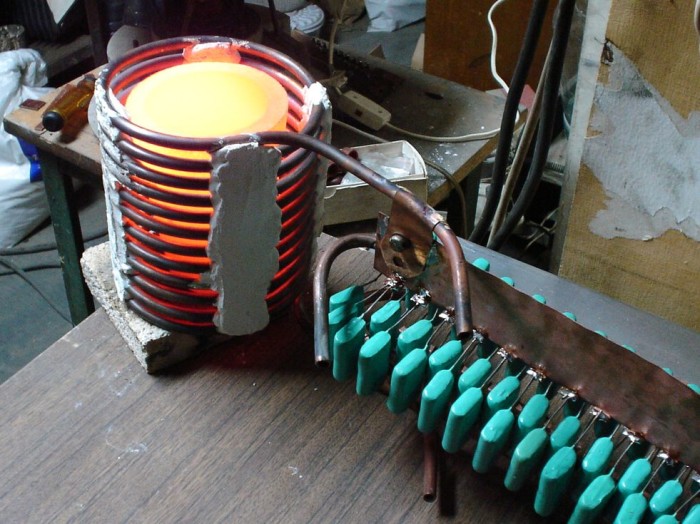
The heating element is an inductor with a steel core in the form of a labyrinth about 7 mm thick, through which the heat agent circulates. The induction current heats the steel core, which in turn heats the liquid.
Microvibrations inside the boiler do not allow scale to settle on heating surfaces, which is a powerful argument for water heating of a private house. Long-term operation does not affect its effectiveness.
This type of boiler does not require expensive annual maintenance and can be installed in any suitable location due to its noiselessness and high degree of fire safety. The heating system based on an induction boiler is a closed circuit with an expansion tank and forced circulation.
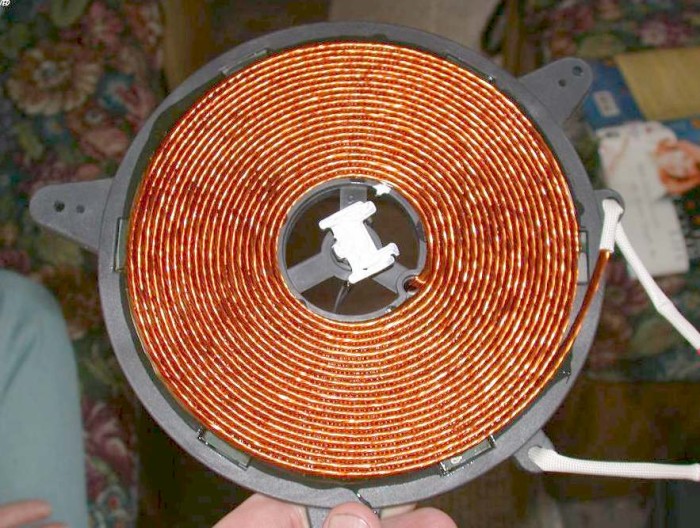
The price of the device is comparable to high-quality heating element boilers. To heat a garage or a small one-story building using an electric boiler, it will be enough to organize a dedicated 220 V line and use a single-phase device. To heat a room with a large area, you will need to connect a 380 V line and use a three-phase current unit.
Alternative systems
Competition in the market for heating systems for electric boilers comes from installations running on diesel and solid fuels (including pellets), as well as gas and combined units.
In practice, when comparing the technical and economic indicators of the presented boilers, we can conclude that electrical installations for heating a residential building are one of the best options for use. Their main advantages are operational reliability, relative low cost of the device, silent operation, ease of installation and full automation.

Not all units are equipped with a full automation system, and some (solid fuel) do not have it at all.
A positive feature of electric boilers among other representatives is their environmental friendliness: during operation, no smoke, soot, or ash is generated, which is extremely important for ensuring fire safety.
Electric boiler of our own production
The beauty of the electrical installation is that, without being able to acquire an industrial design, you can make it yourself. You will need a wiring diagram for the circulation circuit, knowledge of the position of the boiler in this diagram and the method of its installation with further connection.
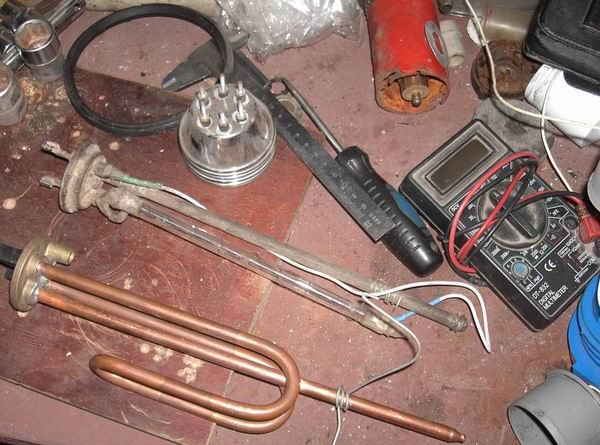
This information will give a clear idea of the shape, dimensions and configuration of the piping pipes.
Mechanical installation work
Knowing the operating principle of the heating system, self-production the boiler will not cause any difficulties. The basis of the body will be a thick-walled steel pipe of the required diameter and length. These parameters are determined by the linear dimensions of the heating elements; in addition, it is worth considering the installation location and configuration of the entire system. Therefore, when starting work, it is necessary to have heating elements or know their measurements.

A sheet of metal pre-prepared in size and suitable in thickness is welded to one of the ends. A flange is selected on the other edge of the vessel. Threaded connections do not seal reliably, so the flange will be butt welded if the internal diameter of the flange is equal to the internal diameter of the body. If it is equal to the outer diameter of the vessel, then it is welded flush with top surface flange. Based on the size of the fastener, the width of the flange is selected, but not less than 30 mm.
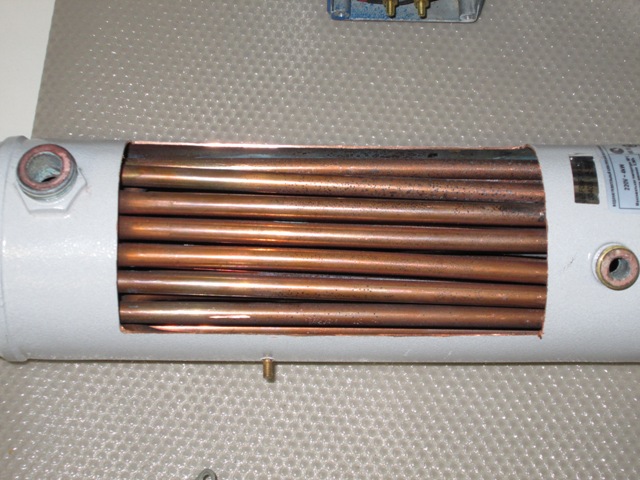
The lid for the future boiler must be made of the same material and in the same dimensions as the flange. This will create an end cap for the flange pair. Holes for fastening must be uniformly drilled on the cover and flange. With a sheet thickness of 3.5 mm or more, a minimum of 6 holes is required. When all the preparatory work has been completed, you need to weld the flange to the flask.
Installation of heaters and piping
To install heating elements, you need to make holes of appropriate sizes in the cover. The heating elements are inserted with the heating surface inside the boiler onto a paronite gasket and covered from the outside with a fastening nut and a sealing washer. When installing the cover, be sure to insert the gasket the right size. It can be cut from a car inner tube, but rubber cannot best option seal operating at high temperatures.
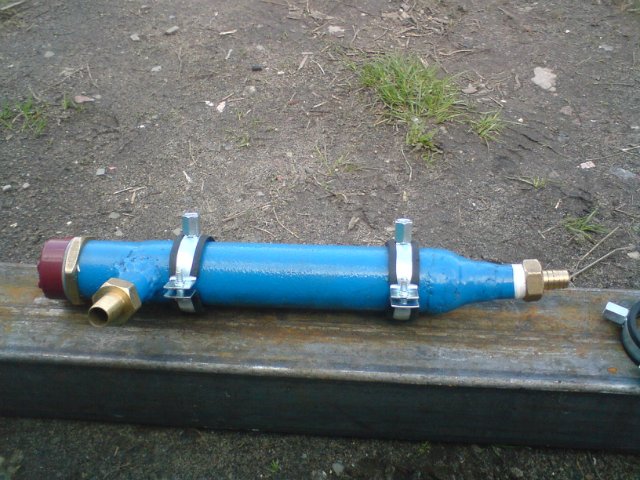
A gasket cut from paronite will provide the necessary mechanical seal and will not change its properties during heating. The mounting holes on the cover and flange must be centered and completely aligned.
The easiest way to achieve this is by simultaneous drilling of both parts, firmly fixed relative to each other.
Homemade electric heating boilers allow you to place the coolant inlet and outlet pipes on the body so as to connect it to the heating system as conveniently as possible. After this, on the boiler in the right places Inserts are made into the direct and return water sockets. The taps are used to make threads for installation of shut-off valves. This will allow the boiler to be removed from the system in the future without emptying it for repairs or cleaning.
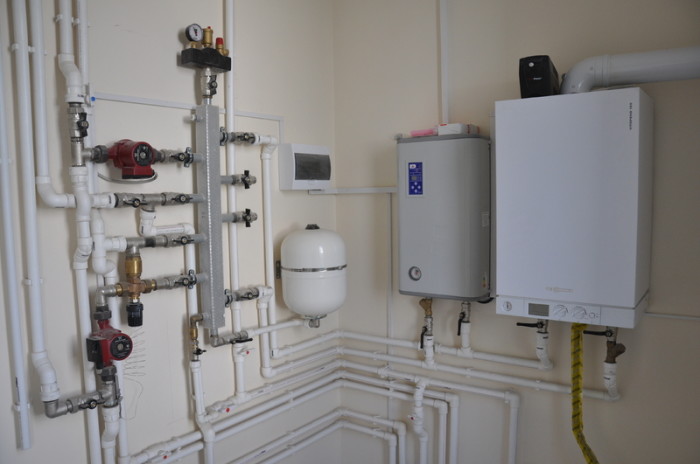
For assembly you will need pipes, a coupling and lock nuts, but you can get by with a tap with a detachable connection on a freely rotating union nut. This connection is called “American”. After hydrotesting (pressurizing the vessel with water) and eliminating leaks, you can move on to the electrical part of the project.
Electrical work
They come down to the correct assembly of the electrical circuit for connecting the heating elements to the electrical network of the house. The zero contact is connected through the terminals to one wire of all heating elements inserted into the boiler. The cross-section of the wire must withstand the load from simultaneously switched on heating elements.
The phase contact is connected to the wire of each heating element through an individual protective device(machine). The machine must comply with the maximum permissible value of the current passing through one heater. The cross-section of the power wire must withstand the load arising from the simultaneous operation of all heating elements.
You won’t be able to save money on heating elements with a built-in relay, since they quickly break due to constant operation. It occurs from changes in the temperature of the water in the boiler and is not consistent with the room temperature. For reasons of electrical safety, all exposed wires and connections must be insulated with your own hands and hidden in a plastic shield or box to limit open access to them.





